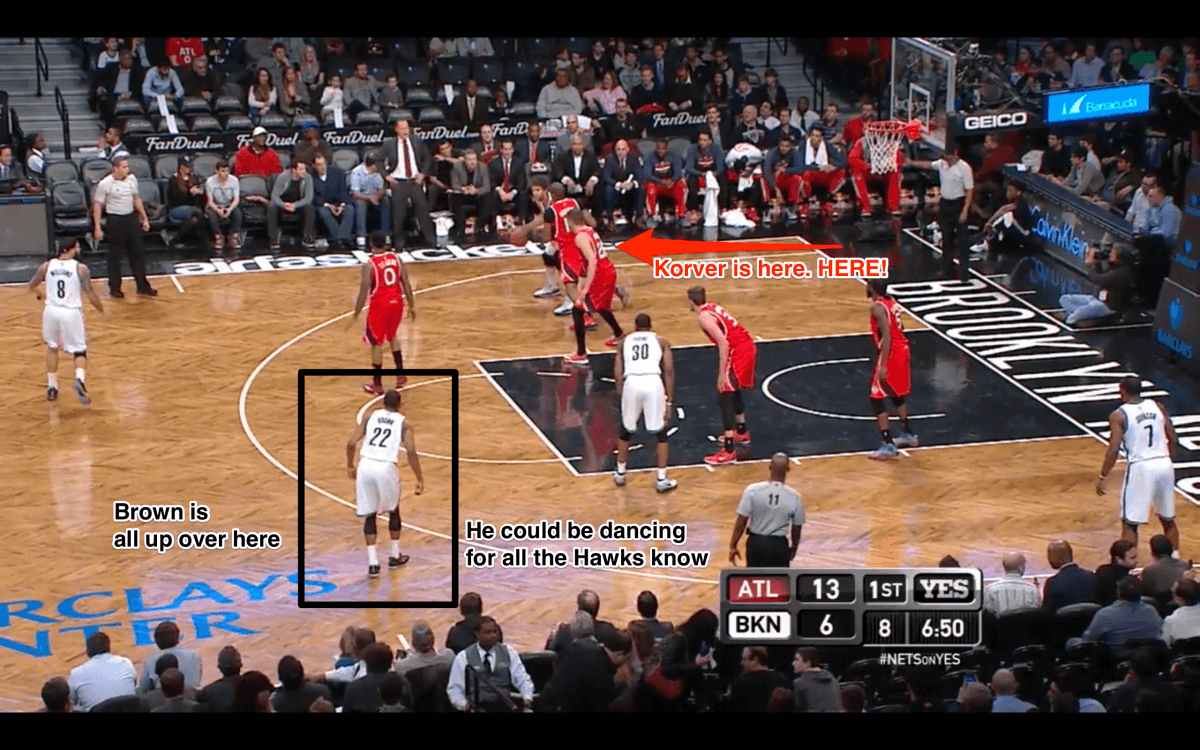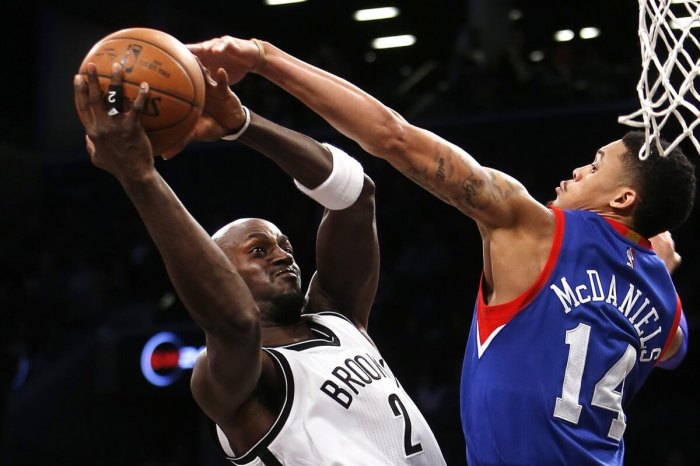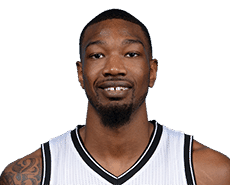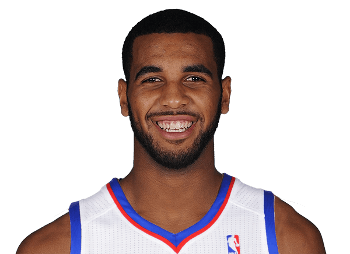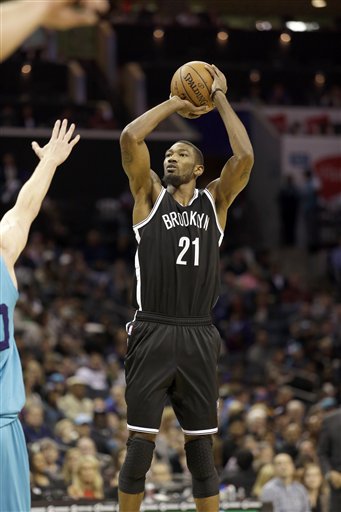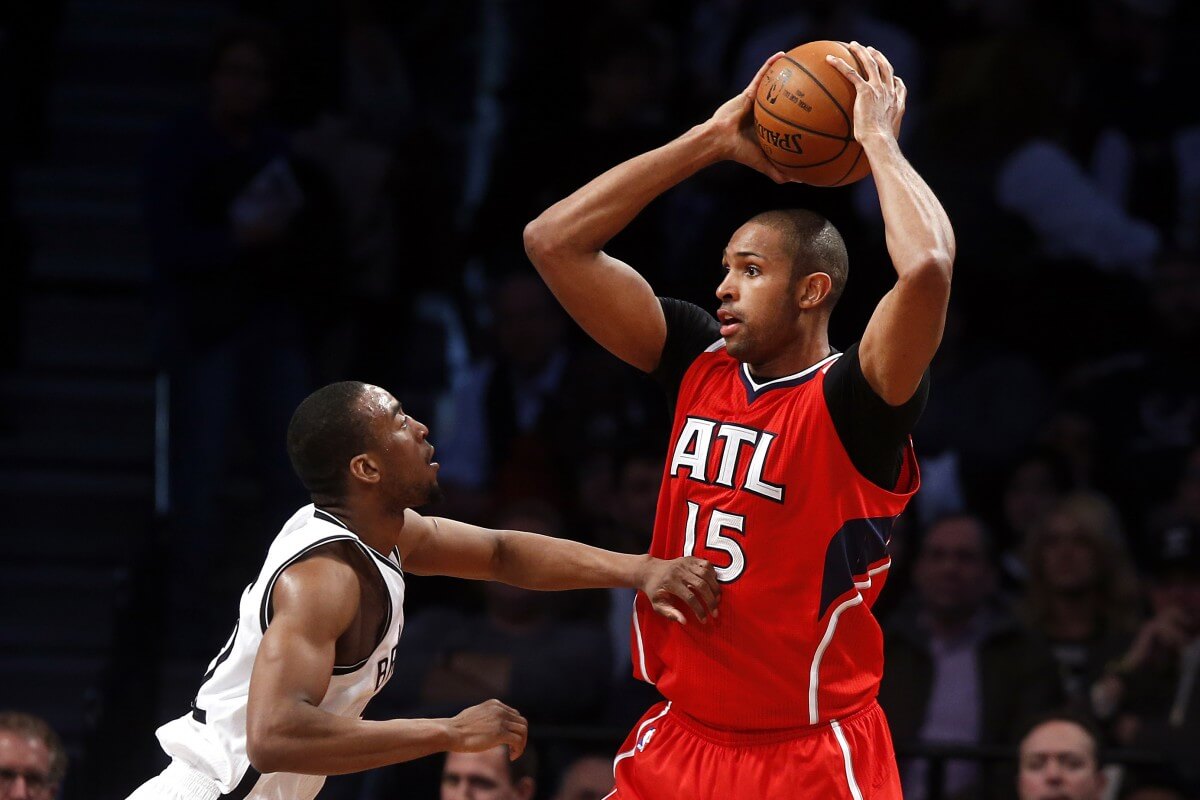
After a regular season sweep, Lionel Hollins held no illusions.
“I don’t think we have any advantages over the Hawks,” Hollins said of his eighth-seeded, 38-44 Brooklyn Nets on a conference call Thursday. “That’s why they’re 60-22 and that’s why we’re where we are.”
Sunday afternoon kicks off the third straight year in the playoffs for the Nets, but they’ll face their toughest task yet: the top-seeded Atlanta Hawks, who swept the Nets in the regular season, winning by an average margin of 17.3 points per game.
Safe to say the Nets are the underdogs. But how will the starters match up? What about the bench? Is there any chance the Nets pull off the upset? Let’s take a look.
The center
Both teams are solar systems that revolve around their center. Brook Lopez is a natural-born scorer that the Nets close possessions with, while Al Horford is the Tim Duncan-lite[note]I said LITE. Stop throwing things at me.[/note] that everything runs through.
Lopez has his advantages, most of them tied to his size: his listed height of 7’0″ undercuts him two inches, and his 7’6″ wingspan allows him to drop in the easy buckets over the shorter Horford, Mike Muscala, and Pero Antic. Any one of them could bully Lopez out of the paint, but Lopez should be able to score if the Nets can get him the ball and he commits to his inside game and pick-and-rolling[note]Not pick-and-sticking![/note] with Deron Williams. If the Nets can get Horford moving away from Lopez and showing on Nets ballhandlers, there are gaps they can squeeze into:
For what it’s worth, Hollins doesn’t see Lopez’s size alone as a reason they can win. “He’s been bigger all four of the games we’ve played them and it hasn’t worked,” Hollins said, half-joking. “He’s had a couple good games, but we have to go play our game. I don’t think keying on one guy, from an offensive perspective, is going to scare the Hawks. We have to scare the Hawks with our whole offensive scheme, of how we move the ball, how we cut and pass and make them have to play the whole court on defense.”
There’s also the matter of rebounding. Lopez has come into his own as a big-time offensive rebounder in the last two months, hanging around the rim and tipping around put-backs, and has held enough ground on the defensive end.
But the Hawks often don’t rebound by design. Much like the Kevin Garnett-led Celtics that routinely finished near the bottom of the league in offensive rebounding, the Hawks have punted crashing the glass. Korver and Teague, the team’s two starting guards, average under 0.7 offensive rebounds per 36 minutes combined: if you’re not a big man in the paint or on the run towards the basket when the shot goes up, you’re running back to limit fast breaks.
It’s paid off: per NBA.com, the Hawks allowed 11.6 fast-break points per 100 total possessions, which ranked fourth-lowest in the NBA, and allowed a league-stingiest 1.01 points per transition possession, per Synergy. The Nets aren’t an athletic transition team anyway, so the Hawks could look to throw DeMarre Carroll into the paint to throw an extra body at Lopez and Thaddeus Young, or stay the course and maximize how they control the tempo.
But while Lopez is a premier scorer, Horford’s strength lies in his versatility. He can shoot: Horford hit 49.4 percent of his long two-pointers, making him one of the rare players that can turn a long two-pointer into an efficient shot. He can pass: his assist rate of 17.8 ranked him fourth among NBA starting centers, and he rarely turned the ball over. His willingness to pass out of decent looks for great ones gives him a massive edge over Lopez. Can you imagine Lopez, for all his inside talents, making this read with regularity?
Or creating this entire play, from leading the fast break to a spin move in the paint that ends in an assist for a corner 3?
There’s not many do-it-all centers in the NBA, but Horford fits the bill: He can finish inside, draw attention in the corners, and is the natural leader in Atlanta’s culture of selflessness. He’s also a master of the “slip screen,” as detailed in that linked article, and if he senses Lopez sneaking too high to cut off Jeff Teague, he’ll make him pay.
One of the things we discussed on the Glue Guys Playoff Preview Podcast was about the best player in this series. If it’s between Lopez and Horford,[note]That’s assuming you don’t make the worthy argument for a healthy Millsap or Korver.[/note] there’s not much of a contest: Lopez is an elite shot creator, Horford is an elite offensive player. Edge: Hawks
The outer circle
If Horford is the sun in Atlanta’s solar system, Kyle Korver is Pluto, orbiting the paint at eclectic, unforeseen angles that few can grasp and fewer can control. The Korver threat is real, and unless you’re a Nets fan, it’s freaking spectacular: watch a frantic Bogdanovic struggle with the decision to cut off Korver in the corner or leave DeMarre Carroll wide open to do whatever the hell he pleased. Just guess what he chose to do.
The crazy part is: that’s the right decision! Giving up a corner 3 to Kyle Korver is akin to possession death. When people say it’s the equivalent of an open layup, they’re actually wrong; a shot from the Korver Korner this season was worth an expected 1.61 points, while the average open layup[note]”Open” defined as at least four feet between the shooter & closest defender, per NBASavant.com.[/note] was only worth 1.45 points.
That’s right: Korver from the corner was a better option than an average NBA player shooting an open layup. It’s like when teams would intentionally walk Barry Bonds with the bases loaded because giving up one run was better than the expected alternative.
You just cannot leave the dude, under any circumstances. There’s a reason why Korver is the only player on the Hawks that has a negative off-court differential — i.e. the Hawks get outscored when Korver sits on the bench — and it’s also no coincidence that the Hawks shredded the Nets with Korver on the floor this season.[note]Plus-minus is inherently flawed, but it’s telling that the closest the Nets came to beating the Hawks came in a three-point game in which Korver was a +25 in 33 minutes.[/note] The attention he draws just by flying around the floor is enough to create open looks for just about anyone he touches, and if you dare sleep on a screen or are slow on a rotation, you might as well crouch into a defensive stance and slide your feet to the bench.
If Alan Anderson’s not 100 percent healthy, Markel Brown might be Brooklyn’s best chance at bothering Korver into an off night or two. But for all his athleticism, Brown still gets hung up on off-ball screens, and the Hawks were happy to double-team anyone on the Nets who could score with Brown on the floor. Hollins switched out Brown for Bogdanovic immediately after this below play, and the Hawks paid him as much attention on the bench. Edge: Hawks
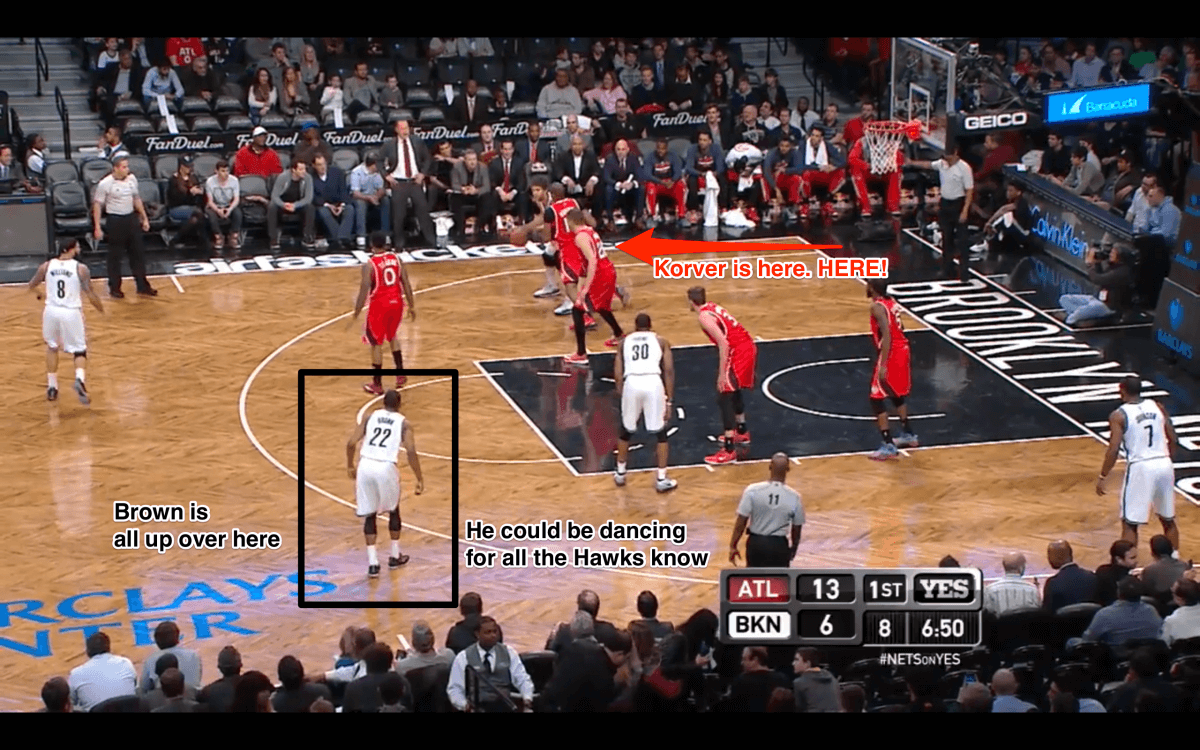
The pay grade
DeMarre Carroll is the de facto defender between he & Korver, and improved his three-point shot from a 28.6 percent clip in his last season with Utah into a near-40-percent shooter two years later. He’s become so valuable that Grantland reported league executives have preliminarily named the next free agent steal “the next DeMarre Carroll.”
Joe Johnson dominated the Toronto Raptors last year by posting up DeMar DeRozan and Terrence Ross to death, and the two were just no match for his 6’7″, 240-pound frame. Johnson bested him in the post twice in the fourth quarter during their last matchup, but Carroll[note]And Mike Scott, who will presumably take his fair share of Johnson’s abuse.[/note] has the length and strength to contend with Johnson that DeRozan didn’t. If Johnson can shake off the rust, hit some spot-up threes, and get weird and make some noise in spot minutes at power forward, this one could be some fun to watch. Edge: Even
The power
There’s a reason why I nearly named Thaddeus Young The Brooklyn Game’s MVP after the regular season. The team flipped the proverbial switch once Young was integrated into the starting lineup after the trade deadline: his presence opened the paint for Brook Lopez in a way Kevin Garnett never could, and he’s made up for the loss of Garnett’s voice with a crafty offensive game and some disruptive defensive plays.
But after seasons languishing in Utah in a tough Western Conference, Paul Millsap finally got his due as an All-Star in each of his first two seasons in Utah. Millsap is Moreyball in Atlanta, taking most of his shots in the paint or from three-point range, rebounding at a solid rate for a power forward, and only developing his outside shot after signing with the Hawks.
Millsap may not be healthy after injuring his shoulder in the Hawks’ blowout win over the Nets on April 4th. He missed five games and only coming back for the last game of the season, when he missed seven of nine shots. Young should give him a challenge, but if he’s healthy, Millsap has just too many weapons in his offensive arsenal. Edge: Hawks
The point
Deron Williams can still create for others off the dribble, and we’ve gone at length in this space about how Williams and Lopez have renewed their chemistry with a sweet pocket pass. He’s averaged 3.4 assists per game to Lopez since the team was 25-38 on March 12th, double his next most common target.[note]Thaddeus Young has received 1.7 assists from Williams per game since March 12th.[/note]
But the other part of that above article, which shows Williams driving to the basket past Avery Bradley, looks like fool’s gold. Williams finished the season with career-lows in two-point percentage (39.5%) and effective field goal percentage (44.3%). He missed 36 of his final 47 shots in the regular season, including an abysmal 6-for-25 from within eight feet:
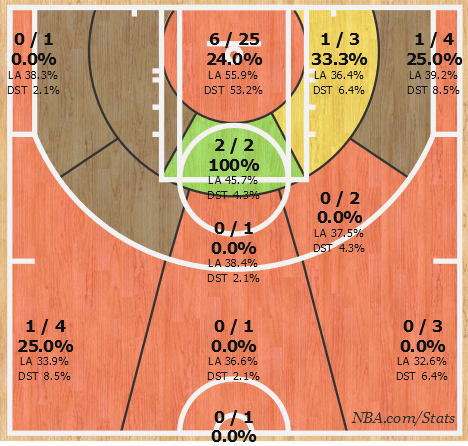
Teague has no such affliction. He finished the season playing limited minutes after Atlanta clinched the top seed, and the Hawks trust him to initiate the offensive action and make quick decisions. He’s the initial prong of a disruptive defense that forces more turnovers per possession than all but two NBA teams, as he’s both able to read passing and driving lanes and use his quick hands to cause deflections.
Williams has some value as a creator for others and a spot-up three-point shooter if he plays off the ball. But Teague runs a high-octane offense and creates havoc defensively, two things Williams can no longer claim. Edge: Hawks
The bench
The playoffs are often where bench units go to pasture. As teams tighten up and seasons hang in the balance, coaches often stretch the minutes of their starters, abandoning their eighth and ninth men. But one or two bench players always make a significant impact, and in 1-8 matchup, the Hawks might look to use their depth to their advantage.
Alan Anderson, Bojan Bogdanovic, and Jarrett Jack make up an alliterative Brooklyn’s Backup Backcourt, with Mason Plumlee and Cory Jefferson getting minutes at the bigs. Hollins has trusted Plumlee with power forward minutes despite the struggles of the Lopez-Plumlee combo this season, and he’ll probably earn those minutes over the rookie Jefferson. Jack is a wild card; with Anderson expected to return, Jack could see fewer minutes next to Deron Williams at shooting guard in what’s been a failed pairing, and fewer minutes overall. Bogdanovic has played starter’s minutes as he’s caught fire in recent weeks, culminating in a career-high 28 points in their near-elimination game against the Orlando Magic. His three-point shooting should be essential in a series like this if the Nets hope to make any noise. Ditto for Anderson, a veteran’s minimum 3-and-D guy who is best spacing the floor.
The Hawks are without their best perimeter defender in Thabo Sefolosha, who suffered a broken leg following an altercation with the NYPD. But they’ve still got a formidable bench, led by sparkplug point guard Dennis Schröder, guard Kent Bazemore, swing forward Mike Scott, and bruising center Pero Antic. Their depth is one of their strengths, and they’ll likely look to take full advantage. Edge: Hawks
The stakes
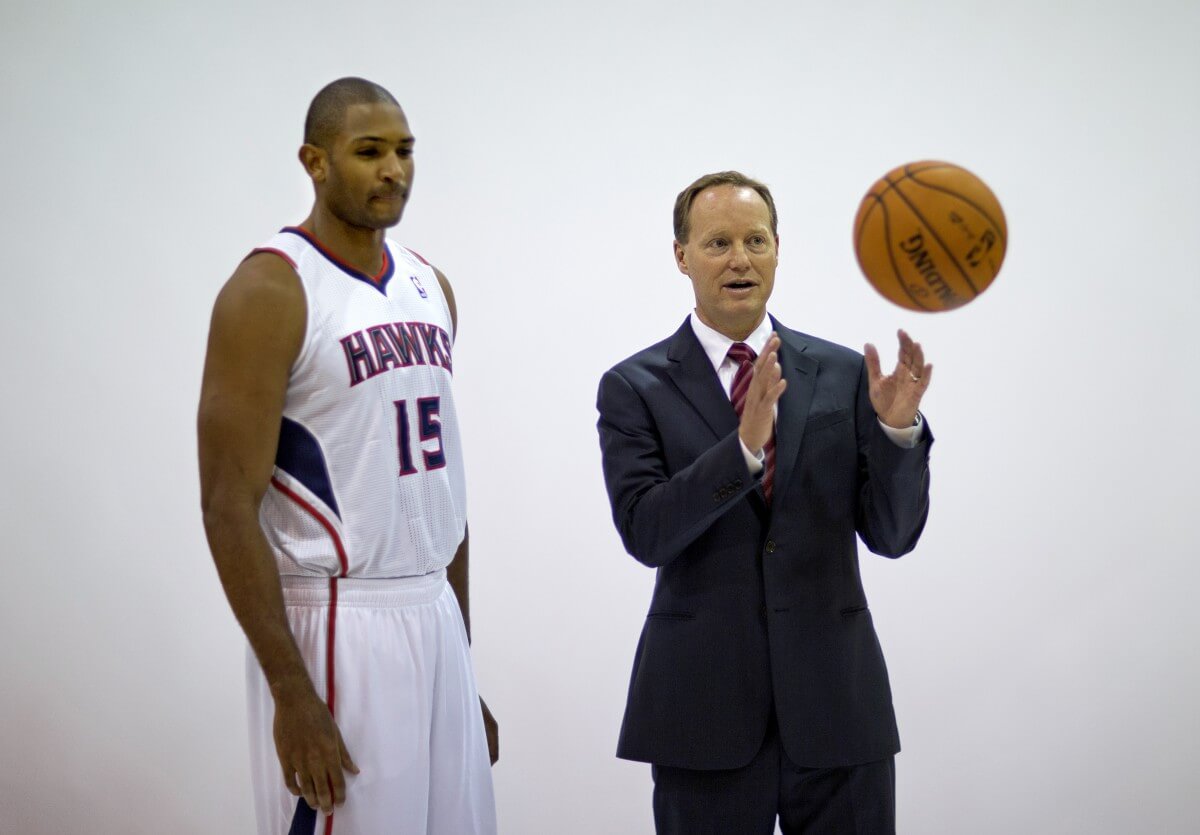
A lion’s share of coaching at the NBA level involves finding a system that maximizes your players and developing the trust to implement and foster it. Hawks coach Mike Budenholzer has gone above and beyond, and the results speak for itself. You’ll see each rotation player’s influence lurking in the above videos, whether it’s Teague’s passing to and from Horford, Korver’s attention-grabbing, or just the general movement from one player to another. Defensive adjustments to this team’s attack largely come down to choosing the more convenient of two evils.
“Their style of play is one of moving the ball and they count on a lot of different people,” Hollins said. “Obviously we think that starts with the ball-handler and the pick-and-roll but it really doesn’t. It starts with they’re pushing the ball up the court and moving the ball from side to side and trying to put you in a disadvantage in certain sets so you have to over-help, and then they throw it and then they draw and kick.”
The feel-good story asserts the Hawks don’t have a superstar. They might not have a 30-point scorer — no, really; no Hawks player scored more than 30 points in a single game this season — but Horford is an all-around superstar in his own right, and the rest of the team falls in line. Korver spaces and screens. Teague sets up pick-and-roll/slip sets and drives to the basket. Carroll defends and spaces the floor. The machine hums.
Team chemistry is a fickle seesaw, and the Hawks maintain an ideal balance. They’re built both on individual talent and with an understanding of each player’s role in a greater cause. The Nets, at times, appear to be half that: a team built on individual talents that have yet to figure out the lock combination to sustained success.
But the Nets also have little to play for at this point. They’re massive underdogs in this series, thus no pressure to live up to their favored status. They had home-court advantage against the Bulls and veteran guile against the Raptors. This time around, they can just go out and play and hope to rattle the NBA world, rather than risk facing it after an unexpected loss. For the first time in three Brooklyn seasons, the team is free from the burden of expectation.
There’s a reason for all that: the Hawks are damn good, and the Nets are not. You’re hard-pressed to find a legitimate advantage the Nets can exploit for the entirety of a seven-game series. Winning two games against this Hawks team would be an accomplishment, three would be a shock, and four would turn the NBA world upside down. Hey, anything is possible, right?
(But that’s probably not going to happen.)
Final Prediction: Hawks in five.

